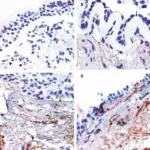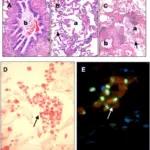Bronchiectasis is permanent dilation of bronchi and bronchioles due to destruction of smooth muscle and elastic tissue by chronic necrotizing infections.
What is the Pathology of Bronchiectasis?
The pathology of bronchiectasis is:
-Etiology: The cause of bronchiectasis is persistent or severe infections, congenital anatomic defects, allergic bronchopulmonary aspergillosis, connective-tissue disorders, and immunodeficiency states.
-Genes involved: Cytotoxic T-lymphocyte antigen (CTLA) 4.
-Pathogenesis: The sequence of events that lead to bronchiectasis, after episodes of infections the bronchial walls are enfeebled and lack support, and are extended by the force of inspiration. The dilated bronchi become packed together with loss of the prevailing lung parenchyma. Squamous metaplasia often follows and eventually the cavities become chronically infected.
-Histology: The histology associated with bronchi shows a marked increase in goblet cells and excess mucus production with plugging of the airway lumen, inflammatory infiltration, and fibrosis of the bronchiolar wall. The pleura in the affected area is adherent and shows bands of fibrous tissue.
How does Bronchiectasis Present?
Patients with bronchiectasis typically affect females than males present at age range of 60 years. The symptoms, features, and clinical findings associated with bronchiectasis include recurrent bronchopulmonary infection; coughing; production of copious amounts of foul-smelling, purulent sputum; and hemoptysis. Weight loss and anemia are common.
How is Bronchiectasis Diagnosed?
Bronchiectasis is diagnosed based on history and imaging studies, chest radiographs. Chest CT scanning allows for definitive diagnosis.
How is Bronchiectasis Treated?
Bronchiectasis is treated through acknowledgment and treatment of episodic infections, regular postural drainage, and chest physical therapy.
What is the Prognosis of Bronchiectasis?
The prognosis of bronchiectasis is good when treatment regimens are adhered to.



